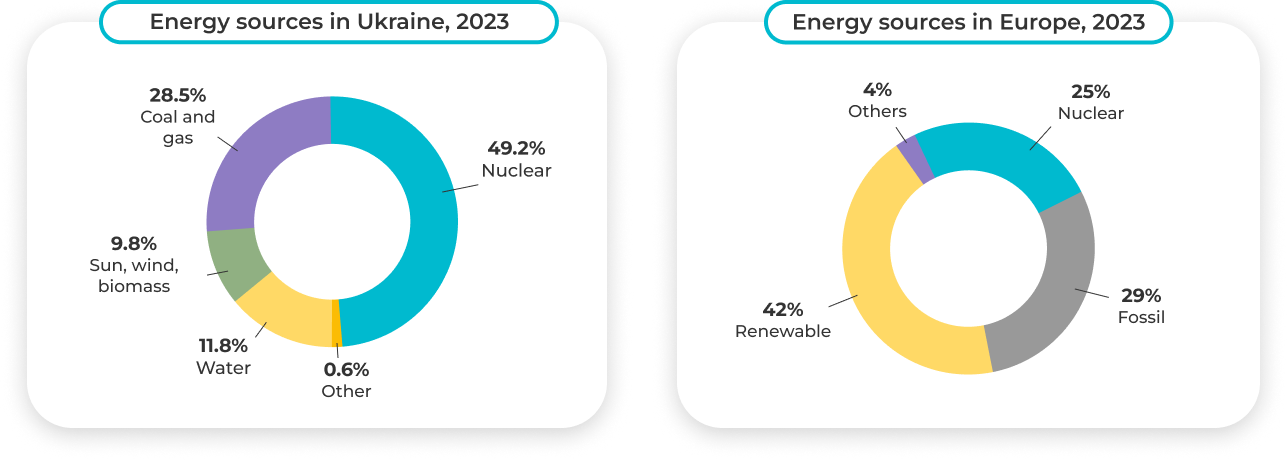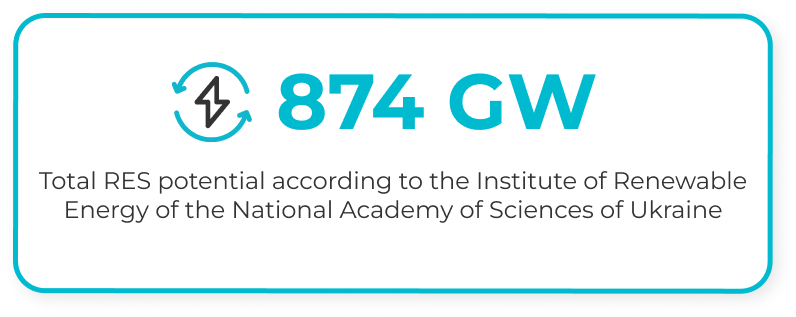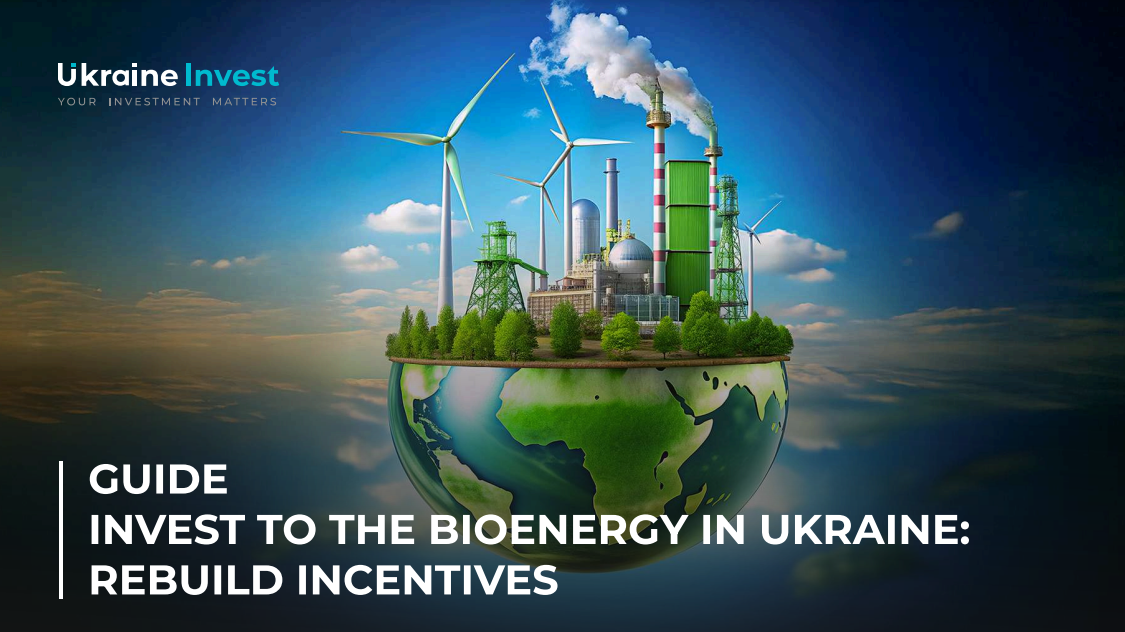Alternative energy
Given Ukraine’s high average wind speed, significant solar energy potential, and increasing volume of agricultural waste, the country’s renewable energy sector has substantial growth potential. Before the full-scale invasion, renewable energy accounted for 8.1% of the total energy system. In 2019, Ukraine ranked among the top ten countries globally for renewable energy development and was sixth in investment attractiveness in the “green” energy sector. Over the past decade, more than USD 12 bln has been invested in renewable energy.
In 2023, the share of renewable energy sources (RES) in Ukraine’s electricity production structure, including large hydropower plants, reached 22%, while in Europe, this figure was 42%.

Before the full-scale invasion, Ukraine’s installed RES capacity was 9.9 GW, including 2 GW of wind energy, 6 GW of solar energy, and 0.2 GW of biomass. As of early 2024, renewable energy capacity stood at 8.7 GW. Despite the war’s challenges, in 2023, DTEK Networks connected over 1,400 new RES facilities to the system, commissioning 182.3 MW of wind and approximately 500 MW of solar power plants. In 2023, Ukrainian businesses invested around USD 150 mln in solar energy.

The plan is to reduce greenhouse gas emissions to 35% of the 1990 level and achieve carbon neutrality by 2060 by replacing coal energy with renewable sources. Since 2009, the “Green Tariff” has encouraged private owners to install their own power generation facilities to sell electricity to the state. The green tariff rate in 2024 is 0,117 euro per kWh. Private companies can implement alternative energy sources such as solar panels, wind turbines, and small hydropower plants, contributing to the sustainable development of Ukraine’s energy sector.
Solar Energy
Solar energy in Ukraine is still in its early stages but has significant potential. Ukraine’s annual solar energy volume is higher than that of Germany, one of the industry leaders. From 2018 to 2020, solar energy capacity increased nearly fivefold. As of 2024, solar power plants account for about 75% of “green” energy production in Ukraine (excluding large hydropower plants). There are currently around 1,400 solar generation facilities of various capacities in the country, owned by 931 licensees, according to the NERC registry as of April 24, 2024.
Solar insolation in Ukraine ranges from 1100 to 1500 kWh/m², making the entire country suitable for solar power plant deployment. The southern regions of the country are optimal for operation. Approximately half of all solar power plants are concentrated in six regions: Ivano-Frankivsk, Dnipropetrovsk, Vinnytsia, Khmelnytskyi, Kyiv, and Mykolaiv. The least number of plants are in Luhansk, Donetsk, Sumy, and Poltava regions. Over two years of war, about 13% of industrial solar power plants were destroyed or damaged, and these capacities need to be restored as soon as possible.

Wind Energy
The northeastern regions of Ukraine have the greatest potential for wind power plants, with an average wind speed exceeding 7 m/s. Before the full-scale invasion, Ukraine had 34 wind power plants with 699 wind turbines generating electricity at an average capacity of 3.5 MW.
In 2023, the most significant new power plant commissioned was DTEK’s Tiligul wind power plant in the Mykolaiv region, with a generating capacity of 78 MW. Unfortunately, about 80% of wind generation was occupied or damaged, presenting challenges but also opportunities for investment in the restoration and development of wind energy in Ukraine.

Bioenergy
The agricultural sector, one of the largest in Ukraine’s economy, generates an increasing amount of agricultural waste, a key resource for biomass-based electricity production. Government policy actively promotes the development of this renewable energy sector, given that labor and raw material costs are among the lowest in Europe. The structure of Ukraine’s bioenergy sector is as follows:
– 70% — solid biomass;
– 15% — biogas:
– 15% — liquid biofuels.
Biomass production potential is about 34 mln tons annually from 94 million tons of agricultural waste. The main raw materials include cereal straw, sunflower, and corn processing residues. Additionally, developing bioenergy reduces dependency on traditional fossil fuels, lowers greenhouse gas emissions, and creates new jobs in rural areas. Investing in bioenergy also supports economic growth, energy independence, and efficient use of agricultural resources.

Hydropower
Ukraine’s hydropower sector has suffered significant losses due to military aggression, totaling approximately USD 3 bln. Around 45% of hydropower capacities were destroyed. In 2023, the Kakhovka HPP was destroyed. Kaniv HPP and Dnipro HPP stations were damaged. Attacks on hydroelectric power plants resulted in the loss of about 2500 MW of capacity.
Ukraine has 10 large hydroelectric power plants operated by Ukrhydroenergo, 3 pumped storage power plants (PSPPs), and about 50 small hydropower plants producing up to 200 million kWh of electricity. Most of these are owned by local communities or private owners. Major hydropower capacities are concentrated on the Dnipro and Dniester rivers, but there is potential for new plant installation in all regions with rivers, including the Carpathian rivers, which can provide significant energy supply to western regions. Ukraine’s Black Sea coastline is 1,540 km, and the Azov Sea coastline is 1,472 km, creating opportunities for wave energy extraction once coastal zones are liberated.
Developing hydropower in Ukraine can be enhanced by investing in the restoration of destroyed and damaged plants and constructing new facilities, increasing energy security, and ensuring stable electricity supply to different regions of the country.

Nuclear Energy
Ukraine’s nuclear power plants ensure a stable operation with long service life. Most power units were commissioned in the 1980s, with their service life ending after the 2040s. Nuclear energy plays a key role in Ukraine’s energy sector, providing 49,2% of the country’s total electricity demand as of 2023. Ukraine is one of the leaders in electricity production in Europe, ranking fifth in total electricity production. Globally, among 33 countries, Ukraine ranks sixth in nuclear power generation, seventh in the number of nuclear reactors, and fifth in Europe. This highlights the importance and efficiency of nuclear energy in the country’s energy sector, as well as its critical role in ensuring a stable and reliable energy supply. The total capacity of 15 current nuclear power units is 13,835 MW.
Ukraine has prospects for developing small modular nuclear reactors and implementing new technologies in this area, allowing the creation of its own production. The capacity of such modular nuclear reactors can range from 50 to 500 MW, opening wide opportunities for investors and promoting further development of nuclear energy in Ukraine.

UkraineInvest has developed a comprehensive guide, “Invest to the bioenergy in Ukraine: rebuild incentives”, to provide entrepreneurs with essential information for implementing investment projects in the bioenergy sector.









